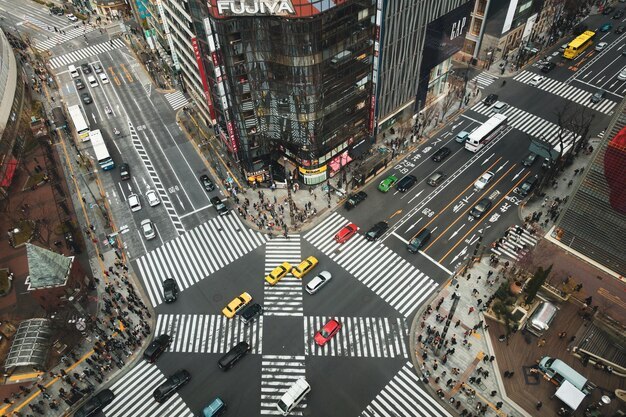
As we know, Shibuya Crossing is situated in Tokyo and is one of the busiest pedestrian crossings in the world. But there’s more to it than just the thousands of people walking across at once. This famous intersection has become a symbol of Tokyo’s fast-paced urban energy, vibrant nightlife, and seamless organization amid chaos. Whether you’re visiting Tokyo for the first time or have been here before, standing in the middle of Shibuya Scramble Crossing is an experience like no other.
With thousands of people crossing every few minutes, it’s often compared to a human wave, moving in perfect harmony despite the sheer volume of foot traffic. Shibuya Crossing represents more than just a pedestrian intersection—it’s a cultural landmark, a visual spectacle, and a prime spot to witness the heartbeat of Tokyo. In this blog, we’ll dive deep into why Shibuya Crossing is famous, the best viewing spots, the history behind it, and why it remains one of Tokyo’s must-visit locations.
Shibuya Crossing is famous because it perfectly embodies the organized chaos of Tokyo. At peak hours, nearly 3,000 people cross the intersection at the same time, making it one of the most crowded pedestrian crossings in the world. Unlike standard intersections, it follows a “scramble crossing” system, meaning all vehicle traffic halts at once, allowing people to cross in every direction—including diagonally. The sheer number of people moving simultaneously, combined with massive LED billboards, flashing advertisements, and neon lights, creates a mesmerizing urban spectacle. It has been featured in numerous movies, TV shows, and travel documentaries, making it a globally recognized symbol of Japan’s capital city. Films like Lost in Translation and The Fast and the Furious: Tokyo Drift have captured its electric energy, further solidifying its status as a must-see Tokyo attraction.
Experiencing Shibuya Crossing isn’t just about walking through it—it’s about taking in the atmosphere from different perspectives. Whether you’re capturing time-lapse footage, watching from above, or just standing amidst the crowd, there are multiple ways to enjoy this Tokyo landmark. The best way to immerse yourself in the experience is simply to cross. The feeling of being surrounded by hundreds of people moving in every direction, under the glow of neon billboards, is unforgettable. If you want to see the crossing from above, head to Shibuya Sky, an open-air rooftop observatory offering panoramic views of Tokyo and a bird’s-eye view of the crossing. Starbucks Shibuya Tsutaya is another popular viewing point, located on the second floor with large glass windows overlooking the intersection. Alternatively, you can watch from the Shibuya Station second-floor windows, which provide a fantastic side view of the action. The experience at Shibuya Crossing differs depending on the time of day. During the day, it’s easier to appreciate the sheer scale of the crowd. At night, the illuminated billboards, neon signs, and city lights create a dazzling cinematic feel, making it the perfect time for photography.
Shibuya has long been a major commercial and entertainment hub, but the Shibuya Scramble Crossing as we know it today developed in the late 20th century. The area has grown significantly over the years, becoming a center for shopping, fashion, and youth culture. Shibuya Station, which serves multiple major train lines, brings in millions of commuters and travelers daily, contributing to the crossing’s high foot traffic. Over time, the crossing has evolved into a symbol of Tokyo’s modern urban culture, reflecting the city’s efficiency, innovation, and vibrant energy. Unlike other crowded intersections worldwide, Shibuya Crossing remains remarkably orderly, with people flowing seamlessly through the space without disruption.
It’s one of the most photographed places in Japan. Tourists, filmmakers, and photographers all flock to capture its dynamic energy. Shibuya Crossing is busiest during rush hours (morning and evening) when Tokyo’s workforce commutes to and from their jobs. A single traffic light cycle lasts around 47 seconds, during which thousands of people cross at once. It’s been featured in multiple Hollywood films, music videos, and travel vlogs, further adding to its global recognition.
Beyond being a busy pedestrian intersection, Shibuya Crossing represents Tokyo’s modern identity. The surrounding shopping districts, entertainment centers, and tech stores reflect the city’s love for innovation, fashion, and pop culture. Just a short walk away, you’ll find Shibuya 109, a famous fashion mall catering to Tokyo’s trendsetting youth. Nearby, Hachiko Statue, the beloved memorial of the loyal Akita dog, is a must-visit spot. This statue represents unwavering loyalty and is one of the most heartwarming landmarks in the city. The story of Hachiko, who waited daily at Shibuya Station for his owner even after his passing, remains one of Japan’s most touching tales.
If you’re visiting Tokyo, experiencing Shibuya Crossing is a must. It’s not just about the spectacle—it’s about feeling the energy of Tokyo, being part of a seamless yet chaotic moment, and immersing yourself in the rhythm of the city. Whether you’re a traveler, a photographer, or just someone looking to experience the essence of Japan’s capital, Shibuya Crossing is one of the most unforgettable places in Tokyo.
Shibuya Crossing is more than just a pedestrian intersection; it’s an experience that encapsulates Tokyo’s urban pulse, high-energy lifestyle, and unique ability to blend order with chaos. From its history and cultural significance to its dazzling lights and cinematic presence, it’s no surprise that millions of people are drawn to this spot every year. Whether you walk through it, watch from above, or capture it in a time-lapse, Shibuya Crossing is a must-see Tokyo attraction that never loses its charm.
